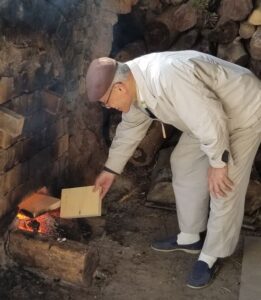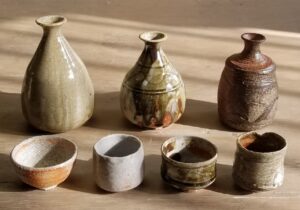西念秋夫(Akio Sainen)<日本の手仕事展2023>
日本の手仕事展2023 ~持続可能なものづくり~


陶芸作家 Ceramist
西念秋夫 Akio Sainen
【作家メッセージ】
「須恵器とは」
弥⽣時代に中国より倭国に来た徐福は、中国の⽂化を伝えました。その内に酒造りと、銅の酒器と楽器の銅鐸(どうたく)を伝えました。
その後、古墳時代に⼊ると、墓作りに必要な副葬品として埴輪と陶器(すえき)が作られるようになり、朝鮮より陶質⼟器が⼊ってきます。
その多くは泉北堺で窯を作り、古墳⽂化を⽀えました。
応神は九州より東へ攻め、熊野より徐福の⼦孫である三⾜烏を掲げる⼈達に案内をされ三輪⼭に王庁を作ります。
三輪⼭を御神体として祭りをするのですが、⼤物主の祭礼を泉北陶新(すえあらた)神社の⼤国主の⼦孫である⼤⽥⽥根⼦を迎えて酒を造り、祭りを⾏いました。それで、酒造りの始まりは三輪神社となったのです。
泉北では甕や(はそう)・⾼坏・坩(かん)・蓋坏など酒宴に必要な銅器の代⽤である陶器(すえき)が作られ全国の古墳に送られました。
後に現代の陶器(とうき)と呼ばれる字と同じであった陶器(すえき)には須恵器の字を充てられました。
【Message from the Artist】
What is Sue pottery?
When Xu Fu came to Japan from China in the Yayoi period, he introduced Chinese culture to Japan. Some examples are sake brewing, copper drinking cups, and the musical instrument Dotaku (bronze bells).
Later, in the Kofun period, haniwa clay figurines and sueki pottery were made as burial accessories, and toushitsu-doki earthenware was introduced from Korea.
Many kilns were built in the Senboku Sakai area to support the Kofun culture.
Emperor Ojin attacked east from Kyushu and was guided by the descendants of Xu Fu whose flag was the three-legged crow, from Kumano to Mt. Miwa, where he built a royal palace.
Mt. Miwa was worshiped as a sacred site, and the festival of the God Omononushi was celebrated by welcoming Otataneko, the descendant of the God Okuninushi of the Senboku Suearata Shrine to make sake and celebrate the festival. Thus, Miwa Shrine’s tradition of brewing sake began.
The word “sueki” (須恵器) was later given the character for Sue pottery (陶器), which is the same as the character for the modern word for pottery 陶器, which is read “toki”.
【経歴・受賞歴・出展歴など】
********************
